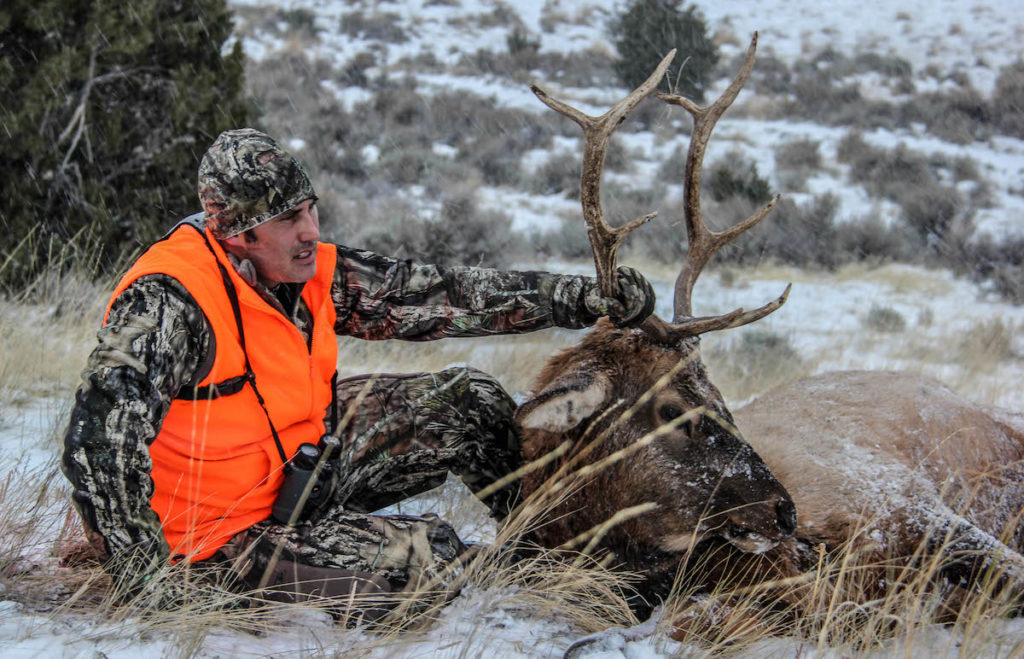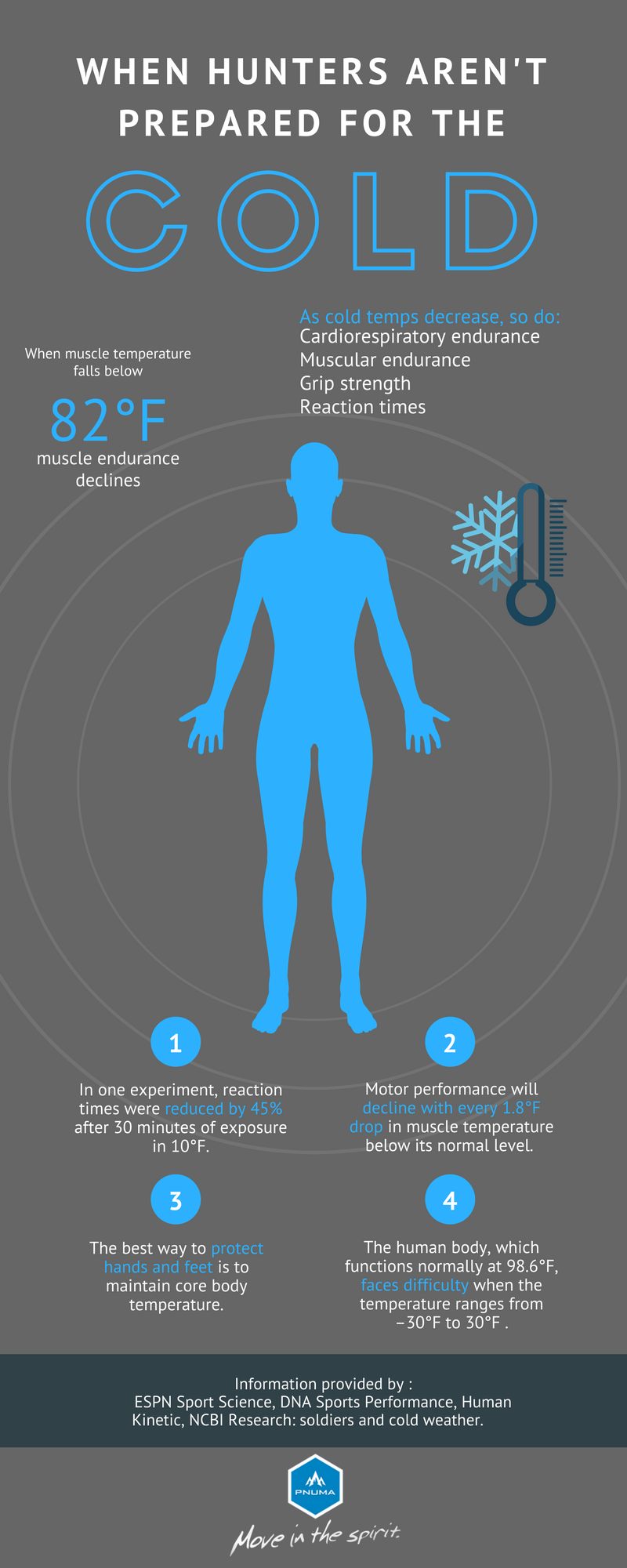If you’ve spent much time hunting in cold temperatures you understand that high-quality clothing is just as important as your bow or rifle. As temperatures drop body heat rapidly escapes, and this heat loss is exacerbated by factors like high winds. If you’re moving while you hunt, the body’s metabolic functions produce heat and will keep your core temperature elevated. But if sitting still — say you're in a deer stand or a duck blind — you’ll get colder more quickly.
The outdoor clothing market is vast, and hunting garments are made from a number of different material options like wool, cotton, and synthetic fibers. Choosing the right clothing—or specifically the right combinations of clothing items—is critically important.
How important? Having the right gear may save your life.
A good friend was hunting elk in northern Idaho’s Bitterroot Mountains when he was set upon by a sudden snow storm that limited visibility and made maneuvering off the mountain difficult. In addition, the temperature dropped sharply and the front brought chilling winds that robbed body heat. By the time that hunter reached his pickup he was nearly hypothermic, and his hands were so cold he was unable to open the door of his truck, eventually using his rifle to press the button and open the door. That goes to show how quickly having the wrong gear can devolve into more than just an uncomfortable situation—your life may depend on the quality of the clothing you wear.
The question, then, is how are garments rated and whether or not those ratings help you select the proper gear.
Heat Ratings
To learn more about heat ratings in clothing, I contacted Ashley Vanderhoof of Signature Products Group in Salt Lake City, Utah. SPG offers an extensive line of branded apparel and footwear, and Vanderhoof helped me demystify how clothing is heat rated.
“A regular garment, like a sweatshirt, isn’t really measured in terms of its insulating properties, it’s measured by its weight,” says Vanderhoof. Clothing companies use a gram per square meter (GSM) measurement to calculate the weight of the fabric for each article of clothing.
“A 400 GSM sweatshirt is heavier and warmer than a 200 GSM sweatshirt, because the weight is calculated at the fabric level per square meter and not by the entire weight of the garment,” says Vanderhoof. Overall weight of the garment can be affected by silhouette, size, and style, so a 400 GSM sweatshirt has 400 grams of fabric per square meter regardless of the size.

During the fall, when temperatures range from 32 to 50 degrees Fahrenheit, most people are comfortable outside in clothes with a total clo rating of about 3.
Some clothes have a clo rating, which Vanderhoof says is a measure of thermal efficiency. A clo rating of 0 indicates no thermal rating — an individual that’s not wearing any clothes at all. A clo rating of 1 is considered the thermal rating that will keep an individual comfortable in a room where the temperature is set at 70 degrees Fahrenheit with an air speed of .1 meters/second and 50% humidity—equivalent to the standard business suit designed to be worn in an office.
Here’s a chart that identifies the clo rating of various clothing items.
| Garment | clo Rating |
| Cotton t-shirt | .09 |
| Light Pants | .20 |
| Flannel Pants | .28 |
| Coveralls | .50 |
| Synthetic Jacket (Heavy) | .35 |
| Long-Sleeved Sweater | .36 |
| 800+ Gram Down Fill | 1.68 |
These clo ratings give an estimate of the level of thermal insulation that each garment provides. During the fall, when temperatures range from 32 to 50 degrees Fahrenheit, most people are comfortable outside in clothes with a total clo rating of about 3, the combined insulation figure for all of your garments. Winter clothing will require a total of 4 or more, and really cold temperatures may require a clo rating of 5 for maximum comfort. Layering increases the clo level.
How Heat is Lost?
Heat is lost when warm air surrounding the body escapes to the outside. There are a number of factors that can affect this. One is humidity; moisture conducts heat more efficiently than air, so in areas with high humidity (or
when you are wet because of perspiration or precipitation) heat loss will be exacerbated. The first key to staying warm, then, is staying dry. This is why moisture-wicking base layers have become so popular.
The second factor in heat loss is air speed. As anyone who’s ever been outside on a windy day knows cold, fast-moving air robs body heat. The most effective ways to prevent heat loss are to stay dry, protect yourself from the wind and to wear enough insulating clothing that body heat cannot escape into the air.
The Benefits of Layering
Most hunters are familiar with the concept of layering your clothes, but layering does more than simply allow you to shed a jacket or overalls if the temperature increases. The key to maintaining heat is to have a base layer, a mid layer and a top layer that all perform well.
The goal of the base layer is twofold. First, the base layer should offer some level of insulation that keeps body heat trapped. Certain materials like merino wool have higher clo ratings than conventional cotton undergarments, so they will naturally keep you more comfortable on the coldest days. The second function of your base layer garment is to allow moisture from perspiration to wick away from the surface of the body. Since sweat transfers heat more efficiently and more quickly than dry air, you need to allow perspiration to escape from the surface of the body.
The primary objective of the mid layer is thermal insulation. This serves to trap body heat and keep the body’s core temperature high. Materials like down and wool, with their high clo ratings, are effective at trapping heat, but a number of synthetic materials like Primaloft also work well. Your top layer will also insulate the body, but exterior garments must also protect you from the elements—primarily wind and moisture. With the right combination of hunting clothes you will remain comfortable on even the coldest days.







